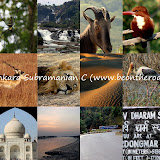Diu – a Portuguese old town!!
Of days gone by...this January during my solo all India motorcycle journey…
Diu, which is part of the union territory of Daman and Diu is a small island that lies off the coast of Gujarat in the Arabian Sea. Diu is separated from the mainland by a long, narrow channel.
After an excellent wildlife experience at the Velavadar Blackbuck National Park, I rode the short distance to the Portuguese old town of Diu. With lots of time on my hand and the sun above my head, I went to explore this town even before checking into a hotel. I was pleasantly surprised by the quiet lifestyle of this idyllic coastal town kissing the Arabian sea. Its this old world charm that gives Diu its character. Diu’s white and golden beaches are unspoilt and lovely. As a bonus, they are relatively quiet and devoid of large crowds, perhaps because of its remote location. This speck of land is far away from any major town and that is what makes Diu such a pure bliss.

Diu’s entire 17 km coastline is technically a beach, but Nagoa, Ghoghla, Jallandar, Chakratirth and Gomtimata are its main stretches of sand. I visited the Ghoghla beach, which is covered with the small fishing boats and some of them offer to provide a sea trip to Diu Fort. I also visited the touristy Nagoa beach, where folks tend to come in for water sports and for some safe swimming. This beautiful beach is frequented by the domestic tourists. The beach that is frequented by the foreign tourist is the isolated Gomtimata beach, which is situated at Diu’s western extremity and close to the Vanakbara jetty.

As I entered the old quarter of Diu through the high city wall on the west, I found quaint houses lining the narrow street. Of these, Nagar Seth’s Haveli was the finest. Not far away from the haveli stands the Church of Saint Francis of Assisi, which was built in 1593. Close by was the Gothic St Thomas Church built in 1598. This church is an imposing sight and serves as a museum of Portuguese relics.

Next, I made by way to the Diu fort (Timings 8 am to 6 pm), which is skirted by the sea on three sides. A lighthouse, some canons, a sub-Jail, carvings, Portuguese artefacts and loads of history made up my view of the Diu fort.
To see India through the eyes of a motorcyclist's lens, visit the album below.
 |
| my solo all-india motorcycle journey |
Continue Reading...










































































